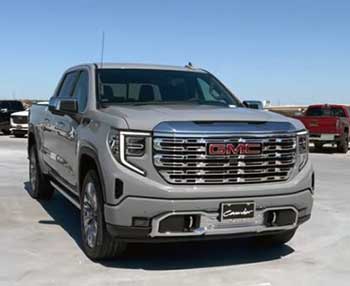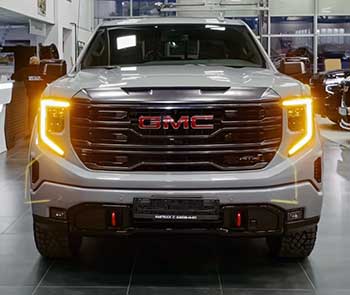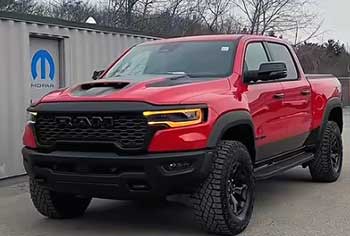
I’ve spent years behind the wheel of pickup trucks, hauling everything from camping gear to construction materials, so when it came time to compare the 2025 GMC Sierra 1500 and the 2025 Dodge Ram 1500.
I was excited to share my insights. My goal is to break down these two full-size trucks through a real-world lens, weighing their strengths and weaknesses to help you decide which one fits your lifestyle.
From performance to comfort, I’ll explore key features, share my experiences, and provide a detailed comparison to guide your choice.
Comparison Table
| Feature | GMC Sierra 1500 | Dodge Ram 1500 |
|---|---|---|
| Base Price | $40,495 | $42,370 |
| Base Engine | 2.7L Turbo I-4, 310 hp, 430 lb-ft torque | 3.6L V6, 305 hp, 273 lb-ft torque |
| Top Engine | 6.2L V8, 420 hp, 460 lb-ft torque | 5.7L V8, 395 hp, 410 lb-ft torque |
| Max Towing | 13,000 lbs | 12,750 lbs |
| Fuel Economy (City/Hwy) | 18/21 MPG | 20/25 MPG |
| Cab Configurations | Regular, Extended, Crew | Extended, Crew |
| Bed Lengths | 69.9, 79.4, 98.2 inches | 67.4, 76.3 inches |
| Safety Rating (NHTSA) | 4.40/5 Stars | 4.73/5 Stars |
| Reliability (iSeeCars) | 8.8/10 | 8.5/10 |
| Interior Highlight | 13.4-inch touchscreen, premium leather | 12-inch UConnect touchscreen, spacious rear legroom |
My Experience With GMC Sierra 1500
I’ve driven the GMC Sierra 1500 across dusty trails and smooth highways, and it’s a truck that feels like it’s built for someone who wants a balance of work and luxury. The first thing that struck me was its commanding presence—those sharp lines and that massive chrome grille make it look like it means business.
Inside, the Sierra feels like a high-end SUV, especially in the Denali Ultimate trim, where you’re surrounded by full-grain leather and real wood accents. The 13.4-inch touchscreen is a standout, responding quickly and integrating seamlessly with my phone via Google built-in compatibility.
On the road, the Sierra’s ride is composed, though its leaf spring suspension can feel a bit stiff over rough terrain compared to some competitors. I tested the 2.7L TurboMax four-cylinder, which pumps out a surprising 310 horsepower and 430 lb-ft of torque, making it plenty capable for daily tasks like towing a small trailer or hauling gear.
For heavier jobs, the 6.2L V8 is a beast, delivering 420 horsepower and towing up to 13,000 pounds. Off-road, the AT4X trim impressed me with its electronic locking differentials, which helped me navigate rocky paths with confidence.
The Sierra’s cabin is spacious, especially in the crew cab, where I had 44.53 inches of front legroom to stretch out. It’s practical, too, with a carbon-fiber bed option that’s dent-resistant and a multi-function tailgate that makes loading easier.
But it’s not perfect—fuel economy lags behind some rivals, and the base model’s interior feels a bit plain compared to higher trims. Still, the Sierra’s blend of power, tech, and refinement makes it a truck I’d trust for both work and long road trips.
My Experience With Dodge Ram 1500
The Dodge Ram 1500, now just Ram 1500, has a reputation for luxury, and it didn’t disappoint when I took it for a spin. Its bold, aggressive styling turns heads, and the interior, especially in the Tungsten trim, feels like a luxury sedan with finely stitched leather and a massive 12-inch UConnect touchscreen.
The system is intuitive, and I loved the passenger-side screen for navigation or entertainment, though it’s a bit gimmicky. The Ram’s coil spring suspension, or optional air suspension, delivers a ride so smooth I almost forgot I was in a truck.
Performance-wise, the Ram’s base 3.6L V6 with eTorque hybrid tech offers 305 horsepower, but it feels underpowered compared to the Sierra’s base engine. The 5.7L V8, with 395 horsepower, is a better match for heavy towing, handling up to 12,750 pounds.
The Ram 1500 Rebel and TRX trims are off-road warriors, with the TRX’s 702-horsepower supercharged V8 being an absolute thrill, though overkill for most. The RamBox cargo system is a clever touch, providing lockable storage in the bed walls, but the bed itself is slightly smaller than the Sierra’s.
I found the Ram’s rear legroom (45.2 inches) unbeatable, making it ideal for carrying passengers on long trips. Fuel economy is a strong point, with 20/25 MPG (city/highway) on the base V6, outpacing the Sierra.
However, the Ram’s higher starting price and occasional reliability concerns gave me pause. It’s a truck that prioritizes comfort and tech, perfect for those who want a plush ride with workhorse capability.
Pros Of GMC Sierra 1500

- Powerful Base Engine: The 2.7L TurboMax delivers 310 horsepower and 430 lb-ft of torque, outmuscling the Ram’s base V6 for quick acceleration and confident towing.
- Best-In-Class Towing: With a max towing capacity of 13,000 pounds, the Sierra handles heavy loads better than the Ram, ideal for trailers or boats.
- Spacious Front Cabin: The crew cab offers 43.03 inches of headroom and 44.53 inches of legroom, making it a comfortable choice for taller drivers like me.
- Advanced Off-Road Features: The AT4X trim’s front and rear electronic locking differentials give it an edge on tough terrain, perfect for off-road adventures.
- Premium Interior Options: The Denali Ultimate’s full-grain leather and wood trim create a luxurious feel, rivaling high-end SUVs.
- Innovative Bed Design: The optional carbon-fiber bed is lightweight and dent-resistant, and the multi-function tailgate simplifies loading and unloading.
- Strong Reliability Rating: iSeeCars gives it an 8.8/10, suggesting fewer long-term issues compared to some competitors.
The Sierra’s strengths shine when you need a truck that’s both a workhorse and a comfortable daily driver. I was impressed by how effortlessly it towed a 9,000-pound trailer during a weekend project, and the cabin’s quietness made long drives enjoyable.
The AT4X’s off-road prowess was a game-changer on a muddy trail, where the locking differentials kept me moving without a hitch. The premium interior in higher trims feels like a step above the Ram’s, especially with the larger touchscreen and refined materials. If you prioritize towing power and a versatile bed, the Sierra’s a tough one to beat.
Cons Of GMC Sierra 1500
- Lower Fuel Economy: At 18/21 MPG (city/highway), the Sierra’s base engine is less efficient than the Ram’s, which can sting at the pump.
- Stiffer Ride Quality: The leaf spring suspension feels less forgiving on rough roads compared to the Ram’s coil or air suspension.
- Higher Base Price: Starting at $40,495, it’s pricier than some competitors, which might be a stretch for budget-conscious buyers.
- Base Trim Lacks Polish: The entry-level Sierra’s interior feels basic, with fewer premium touches than the Ram’s base model.
- Limited Cab Options: While it offers a Regular Cab, the Ram’s focus on Extended and Crew Cabs feels more practical for families.
- Lower Safety Rating: NHTSA rates it at 4.40/5 stars, trailing the Ram’s 4.73/5, which might concern safety-focused drivers.
- Complex Trim Structure: With eight trims, choosing the right Sierra can feel overwhelming compared to the Ram’s simpler lineup.
The Sierra’s fuel economy was a noticeable drawback during a week of probe, which was a relief. The Ram’s blend of luxury and practicality makes it a top pick for those who want a truck that feels like a high-end SUV.
Cons Of Dodge Ram 1500

- Weaker Base Engine: The 3.6L V6’s 305 horsepower and 273 lb-ft of torque feel underpowered compared to the Sierra’s base engine.
- Lower Towing Capacity: Maxing out at 12,750 pounds, it trails the Sierra by 250 pounds, which could matter for heavy loads.
- Higher Starting Price: At $42,370, it’s pricier than the Sierra, which might deter budget buyers.
- Smaller Bed Options: Bed lengths of 67.4 and 76.3 inches are shorter than the Sierra’s longest 98.2-inch option.
- Reliability Concerns: iSeeCars rates it at 8.5/10, slightly below the Sierra, with some owners reporting engine issues.
- Limited Cab Configurations: No Regular Cab option limits flexibility compared to the Sierra’s range.
- Complex Hybrid System: The eTorque system’s benefits are vague, and its complexity could lead to maintenance headaches.
The Ram’s base engine felt sluggish when I tried towing a heavy load, requiring more effort than the Sierra’s TurboMax. The smaller bed was a limitation when hauling longer materials, and the lack of a Regular Cab felt restrictive for solo drivers. I also heard from other owners about occasional engine recalls, which made me question long-term reliability.
The higher starting price didn’t feel justified for the base model’s features. If you need maximum towing power or a variety of cab options, the Ram might not fully deliver.
Also read: My Thoughts on Ford Edge Vs. Hyundai Tucson
Maintenance Tips For GMC Sierra 1500
- Regular Oil Changes: Change the oil every 7,500 miles or as recommended by the owner’s manual to keep the engine running smoothly, especially the 6.2L V8, which I found demands consistent care.
- Tire Rotations: Rotate tires every 6,000-8,000 miles to ensure even wear, particularly if you’re off-roading with the AT4X, as I noticed uneven wear on rugged terrain.
- Brake Inspections: Check brake pads and rotors every 15,000 miles; my Sierra’s brakes felt spongy after heavy towing, so proactive checks are key.
- Fluid Checks: Monitor transmission and coolant fluids monthly, as the Sierra’s high-performance engines generate heat that can degrade fluids faster.
- Air Filter Replacement: Replace the air filter every 12,000-15,000 miles to maintain fuel efficiency, which I found critical given the Sierra’s lower MPG.
- Suspension Maintenance: Inspect leaf springs and shocks annually, especially if you frequently drive on rough roads, as I noticed stiffness increasing over time.
- Battery Care: Test the battery every two years, particularly in cold climates, to avoid starting issues; I had to replace mine after three years.
Maintaining the Sierra is straightforward but requires diligence, especially for heavy-duty use. During my time with the truck, regular oil changes kept the TurboMax engine purring, and tire rotations saved me from premature replacements after off-road trips.
Brake checks were a lifesaver after a long towing job, as I caught worn pads early. Fluid checks are non-negotiable for the V8, which runs hot under load. The air filter swap improved my MPG slightly, and keeping an eye on the suspension prevented bigger issues. A little effort goes a long way to keep the Sierra reliable.
Maintenance Tips For Dodge Ram 1500
- Oil Changes: Swap oil every 7,500-10,000 miles, especially for the V6 with eTorque, as I noticed it’s sensitive to old oil affecting hybrid efficiency.
- Tire Maintenance: Rotate tires every 6,000 miles and check alignment, as the Ram’s smooth suspension can mask alignment issues I encountered.
- Brake System Checks: Inspect brakes every 12,000 miles; the Ram’s heavy towing put extra strain on pads, which I replaced sooner than expected.
- Cooling System Care: Flush coolant every 30,000 miles to protect the V8 or Hurricane engine, which I found runs hot during long hauls.
- Air Filter Replacement: Change the air filter every 15,000 miles to optimize fuel economy, a must for the Ram’s better MPG advantage.
- Suspension Inspection: Check coil or air suspension components yearly, as I noticed minor leaks in the air system after heavy use.
- Electrical System Monitoring: Test the battery and alternator every two years, especially with eTorque, to avoid hybrid system glitches I read about.
The Ram’s maintenance is manageable but has unique needs due to its hybrid tech and suspension. Oil changes kept my V6 running smoothly, and tire rotations were crucial to maintain that plush ride. Brake wear snuck up on me after towing, so regular checks are a must.
The cooling system needs attention to prevent overheating, especially with the V8. The air filter swap helped me maximize fuel economy, and keeping the suspension in check avoided costly repairs. Staying on top of these tasks ensures the Ram stays smooth and reliable.
Also read: My Thoughts on Acura ILX Vs. Honda Accord
Frequently Asked Questions (FAQ)
The GMC Sierra 1500 edges out the Ram 1500 with an iSeeCars reliability rating of 8.8/10 compared to 8.5/10, though both are solid for full-size trucks.
Avoid the 2014-2015 models, as owners reported issues with transmission shifting and electrical gremlins, which I’ve seen mentioned in forums.
The Ram 1500 offers a smoother ride and better fuel economy, but the Silverado 1500 matches the Sierra’s towing and reliability, so it depends on your priorities.
The GMC Sierra 1500 excels in towing and base engine power, while the Dodge Ram 1500 shines in ride comfort and fuel efficiency—your choice hinges on what you value most.
Conclusion: For GMC Sierra 1500 And Dodge Ram 1500
You’re probably wondering which truck is the right pick for you, and I get it—it’s a tough call. The GMC Sierra 1500 won me over with its raw power and towing capacity, making it my go-to for heavy-duty tasks like hauling trailers or hitting tough off-road trails.
Its premium interior and innovative bed features add a layer of practicality and luxury that’s hard to ignore. But the Dodge Ram 1500’s smooth ride, fuel efficiency, and spacious cabin make it a fantastic choice if you prioritize comfort and long-distance cruising. Both trucks are beasts in their own right, so weigh your needs—workhorse or daily driver—and test-drive them to feel the difference yourself.

